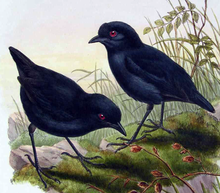Melampitta
| |||||||||||||||||||||||||||
Read other articles:

German ballet company This article needs additional citations for verification. Please help improve this article by adding citations to reliable sources. Unsourced material may be challenged and removed.Find sources: Hamburg Ballet – news · newspapers · books · scholar · JSTOR (February 2024) (Learn how and when to remove this message) General informationLocal nameHamburg BallettYear founded1973 (1973)FoundersJohn NeumeierPrincipal venueBallettzentru…

内華達州 美國联邦州State of Nevada 州旗州徽綽號:產銀之州、起戰之州地图中高亮部分为内華達州坐标:35°N-42°N, 114°W-120°W国家 美國建州前內華達领地加入聯邦1864年10月31日(第36个加入联邦)首府卡森城最大城市拉斯维加斯政府 • 州长(英语:List of Governors of {{{Name}}}]]) • 副州长(英语:List of lieutenant governors of {{{Name}}}]])喬·隆巴爾多(R斯塔夫�…

This article needs additional citations for verification. Please help improve this article by adding citations to reliable sources. Unsourced material may be challenged and removed.Find sources: Getalsud Dam – news · newspapers · books · scholar · JSTOR (December 2014) (Learn how and when to remove this message) Dam in Ranchi, JharkhandGetalsud Dam(Rukka Dam)Getalsud Dam, JharkhandLocation in JharkhandCountryIndiaLocationOrmanjhi, Ranchi, JharkhandCoordin…

American popular music vocal group This article is about the band. For other uses, see Fifth Dimension (disambiguation). This article includes a list of general references, but it lacks sufficient corresponding inline citations. Please help to improve this article by introducing more precise citations. (April 2020) (Learn how and when to remove this message) The 5th DimensionThe 5th Dimension in 1969Back row: Townson and McLemore.Front row: LaRue, Davis, and McCoo.Background informationAlso know…

Japanese polearm This article relies largely or entirely on a single source. Relevant discussion may be found on the talk page. Please help improve this article by introducing citations to additional sources.Find sources: Sodegarami – news · newspapers · books · scholar · JSTOR (January 2017) Weapons for capturing suspected criminals: on the left tsukubō, in the middle sodegarami, and on the right sasumata The sodegarami (袖搦, sleeve entangler) is a p…

This article does not cite any sources. Please help improve this article by adding citations to reliable sources. Unsourced material may be challenged and removed.Find sources: August Schirmer – news · newspapers · books · scholar · JSTOR (August 2009) (Learn how and when to remove this message) August Schirmer as a Reichstag member in 1938 August Schirmer (born 16 June 1905 in Celle; died 30 October 1948 in Celle) was a German architect, engineer, electe…
2020年夏季奥林匹克运动会波兰代表團波兰国旗IOC編碼POLNOC波蘭奧林匹克委員會網站olimpijski.pl(英文)(波兰文)2020年夏季奥林匹克运动会(東京)2021年7月23日至8月8日(受2019冠状病毒病疫情影响推迟,但仍保留原定名称)運動員206參賽項目24个大项旗手开幕式:帕维尔·科热尼奥夫斯基(游泳)和马娅·沃什乔夫斯卡(自行车)[1]闭幕式:卡罗利娜·纳亚(皮划艇)[2…

ヨハネス12世 第130代 ローマ教皇 教皇就任 955年12月16日教皇離任 964年5月14日先代 アガペトゥス2世次代 レオ8世個人情報出生 937年スポレート公国(中部イタリア)スポレート死去 964年5月14日 教皇領、ローマ原国籍 スポレート公国親 父アルベリーコ2世(スポレート公)、母アルダその他のヨハネステンプレートを表示 ヨハネス12世(Ioannes XII、937年 - 964年5月14日)は、ロー…

1937 mass murder of Chinese civilians by the Japanese army For the book by Iris Chang, see The Rape of Nanking (book). Nanjing MassacrePart of the Second Sino-Japanese WarA Japanese soldier pictured with the corpses of Chinese civilians by the Qinhuai RiverLocationNanjing, Republic of ChinaDateFrom December 13, 1937, for six weeks[note 1]Attack typeMass murder, wartime rape, looting, torture, arsonDeaths200,000 (consensus), estimates range from 40,000 to over 300,000Victims20,000 to 80,0…

此条目序言章节没有充分总结全文内容要点。 (2019年3月21日)请考虑扩充序言,清晰概述条目所有重點。请在条目的讨论页讨论此问题。 哈萨克斯坦總統哈薩克總統旗現任Қасым-Жомарт Кемелұлы Тоқаев卡瑟姆若马尔特·托卡耶夫自2019年3月20日在任任期7年首任努尔苏丹·纳扎尔巴耶夫设立1990年4月24日(哈薩克蘇維埃社會主義共和國總統) 哈萨克斯坦 哈萨克斯坦政府與�…

Buniin JayaDesaPeta lokasi Desa Buniin JayaNegara IndonesiaProvinsiKalimantan SelatanKabupatenTapinKecamatanPianiKode pos71191Kode Kemendagri63.05.08.2008 Luas... km²Jumlah penduduk... jiwaKepadatan... jiwa/km² Buniin Jaya adalah salah satu desa di wilayah kecamatan Piani, kabupaten Tapin, Provinsi Kalimantan Selatan, Indonesia. Pranala luar (Indonesia) Keputusan Menteri Dalam Negeri Nomor 050-145 Tahun 2022 tentang Pemberian dan Pemutakhiran Kode, Data Wilayah Administrasi Pemerintahan, …

Artikel ini tidak memiliki referensi atau sumber tepercaya sehingga isinya tidak bisa dipastikan. Tolong bantu perbaiki artikel ini dengan menambahkan referensi yang layak. Tulisan tanpa sumber dapat dipertanyakan dan dihapus sewaktu-waktu.Cari sumber: Day of Defeat – berita · surat kabar · buku · cendekiawan · JSTOR Day of Defeat Diterbitkan diWindowsNA: May 6, 2003EU: May 15, 2003Genrepenembak orang pertamaLisensiperangkat lunak gratis Bahasa Daftar Ing…

PLQ redirects here. For the airport with this IATA code, see Palanga International Airport. Political party in Quebec Quebec Liberal Party Parti libéral du QuébecAbbreviationPLQQLPLeaderMarc Tanguay (interim)PresidentRafael Primeau FerraroFoundedJuly 1, 1867; 156 years ago (July 1, 1867)Headquarters Montréal, Québec, H2R 2Y8 Ville de Québec, Québec, G1S 2P1 Membership (2023)15,000–20,000[1][2]Ideology Liberalism Canadian federalism Economic liberalism Pol…

Notebook computer series made by Samsung Electronics For the note-taking software, see Samsung Notes. Samsung Notebook / Samsung SensDeveloperSamsung ElectronicsManufacturerSamsung ElectronicsTypeLaptopRelease date1995; 29 years ago (1995)2014; 10 years ago (2014)Operating systemWindows, LinuxCPUAMD APU, AMD RyzenIntel Core i3, i5 or i7GraphicsAMD Radeon, NVIDIA GeForce, Intel HDMarketing targetConsumer / Home purposeWebsitewww.samsung.com/ca/pc/all-pc/ Samsun…

У этого термина существуют и другие значения, см. Одесса (значения). ГородОдессаукр. Одеса Против часовой стрелки, начиная с верхнего правого угла: памятник дюку де Ришельё, Воронцовский маяк, городской сад, театр оперы и балета, Приморский бульвар, Потёмкинская лестница Фл�…

For the flower rose as a charge in heraldry, see Rose (heraldry). Rose is the non-traditional tincture of rose or pink as used in heraldry. Rose has been introduced in Canadian heraldry from the late 20th century. It is now considered a colour in Canadian heraldry, along with azure (blue), gules (red), vert (green) and sable (black). The colour features in the coat of arms of former Canadian prime minister Kim Campbell.[1] It remains to be seen whether the tincture will be used in herald…

Cet article est une ébauche concernant une localité des îles Baléares. Vous pouvez partager vos connaissances en l’améliorant (comment ?) selon les recommandations des projets correspondants. Sant Joan San Juan (es) Héraldique Drapeau Vue de Sant Joan. Administration Pays Espagne Communauté autonome Îles Baléares Comarque Pla de Mallorca District judic. Manacor Maire Mandat Catalina Gayà (AxSJ) Depuis 2013 Code postal 07240 Démographie Gentilé Santjoaner/a Population 2 19…

Football in ScotlandSeason2016–17 ← 2015–16 2017–18 → 2016–17 in Scottish footballPremiership championsCelticChampionship championsHibernianLeague 1 championsLivingstonLeague 2 championsArbroathScottish Cup winnersCelticLeague Cup winnersCelticChallenge Cup winnersDundee UnitedYouth Cup winnersCelticTeams in EuropeCeltic, Aberdeen, Heart of Midlothian, HibernianScotland national team2018 FIFA World Cup qualification The 2016–17 season was the 120th season of compe…

Railway company in Switzerland This article includes a list of general references, but it lacks sufficient corresponding inline citations. Please help to improve this article by introducing more precise citations. (April 2021) (Learn how and when to remove this message) Montreux Oberland Bernois RailwayMOB train at Les Avants on 11 July 1985.OverviewNative nameChemin de fer Montreux Oberland BernoisStatusoperating hourly servicesLocaleVaud, Bernese HighlandsTerminiMontreuxLenk i.S.Stations36Webs…

Front TimurBagian dari Perang Dunia IArah jarum jam dari kiri atas: Pegunungan Carpathian, 1915; Para prajurit Jerman di Kiev, Maret 1918; kapal Rusia Slava, Oktober 1917; infanteri Rusia, 1914; infanteri Rumania.Tanggal17 Agustus 1914 – 3 Maret 1918(3 tahun, 6 bulan dan 2 minggu)LokasiEropa Tengah, Timur, & TenggaraHasil Kemenangan Blok central Keruntuhan Kekaisaran Rusia yang berujung pada Revolusi Rusia Traktat Brest-Litovsk (Ukraina), Traktat Brest-Litovsk (Rusia), Trakt…










